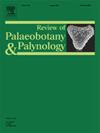圣克拉拉Arriba组古植物学研究(西冈瓦纳奎亚纳盆地中三叠世安尼西亚期)
IF 1.7
3区 地球科学
Q2 PALEONTOLOGY
引用次数: 0
摘要
圣克拉拉Arriba组是一个代表湖泊三角洲沉积环境的阿尼西亚单元,是El Peñasco群圣克拉拉子盆地(阿根廷门多萨圭亚那盆地)的一部分。这篇文章的目的是介绍新的植物化石发现和对圣克拉拉阿里巴组的初步地语学评价。本文还将圣克拉拉Arriba组的古植物学记录与阿根廷El Peñasco组和Anisian组的其他单元进行了比较和分析。圣克拉拉Arriba组的植物化石组合包括Equisetales (Equisetales indet.), Osmundales (Cladophlebis spp.), Marattiales (Danaeopsis sp.), Umkomasiales (Fanerotheca c.papilioformis), Peltaspermales (Peltaspermum spp.), Coniferales (Pagiophyllum sp.)和不确定亲和力的裸子植物(未确定的叶子,?心形花序,胚珠/种子,和球果)。在三角洲-平原相中记录了遗迹,它们的保存归因于快速沉积和持续的高水位。植物古群落被解释为以裸子植物为主的森林,以及一个由裸子植物和马属植物组成的林下植物群落,而马属植物沿着水边形成了河岸群落。该组合的分类组成与该地区其他三叠纪植物区系一致。圣克拉拉Arriba组由于其古地理环境、保存完好的化石记录和健全的年代学框架,为阐明冈瓦纳地区阿尼西亚植被与气候之间的关系提供了宝贵的机会。本文章由计算机程序翻译,如有差异,请以英文原文为准。
Paleobotanical insights from the Santa Clara Arriba Formation (Anisian, Middle Triassic, Cuyana Basin, West Gondwana)
The Santa Clara Arriba Formation is an Anisian unit representing a lacustrine deltaic depositional setting that forms part of the El Peñasco Group Santa Clara sub-basin (Cuyana Basin, Mendoza, Argentina). The objective of this contribution is to present new plant fossil findings and a preliminary taphonomic evaluation of the Santa Clara Arriba Formation. It also includes a comparison and analysis of the paleobotanical record of the Santa Clara Arriba Formation with other units of the El Peñasco Group and Anisian units in Argentina. The plant fossil assemblage of the Santa Clara Arriba Formation comprises Equisetales (Equisetales indet.), Osmundales (Cladophlebis spp.), Marattiales (Danaeopsis sp.), Umkomasiales (Fanerotheca cf. papilioformis), Peltaspermales (Peltaspermum spp.), Coniferales (Pagiophyllum sp.), and gymnosperms of uncertain affinity (undeterminated leaves, ?Cordaicarpus sp., ovules/seeds, and strobili). Remains were recorded in delta-plain facies, and their preservation is attributed to rapid sedimentation and a persistent high-water table. The plant paleocommunities are interpreted as forests dominated by gymnosperms, and an understory comprising Osmundales, and Marattiales, while Equisetales formed riparian communities along water margins. The taxonomic composition of the assemblage is consistent with other Triassic floras from the region. The Santa Clara Arriba Formation provides a valuable opportunity to elucidate the relationship between Anisian vegetation and climate in Gondwana, owing to its paleogeographic setting, well-preserved fossil record, and robust geochronological framework.
求助全文
通过发布文献求助,成功后即可免费获取论文全文。
去求助
来源期刊
CiteScore
3.50
自引率
21.10%
发文量
149
审稿时长
6 months
期刊介绍:
The Review of Palaeobotany and Palynology is an international journal for articles in all fields of palaeobotany and palynology dealing with all groups, ranging from marine palynomorphs to higher land plants. Original contributions and comprehensive review papers should appeal to an international audience. Typical topics include but are not restricted to systematics, evolution, palaeobiology, palaeoecology, biostratigraphy, biochronology, palaeoclimatology, paleogeography, taphonomy, palaeoenvironmental reconstructions, vegetation history, and practical applications of palaeobotany and palynology, e.g. in coal and petroleum geology and archaeology. The journal especially encourages the publication of articles in which palaeobotany and palynology are applied for solving fundamental geological and biological problems as well as innovative and interdisciplinary approaches.

 求助内容:
求助内容: 应助结果提醒方式:
应助结果提醒方式:


